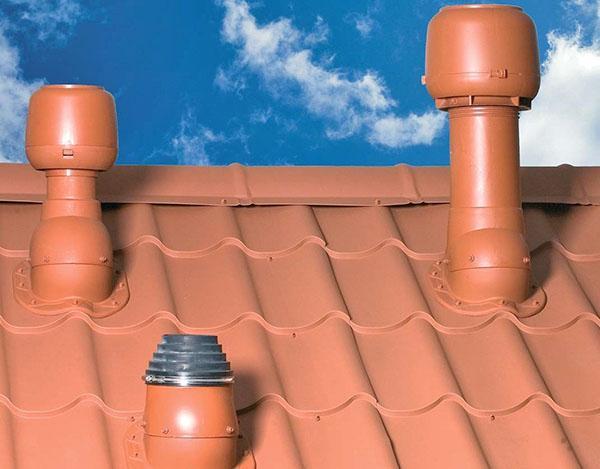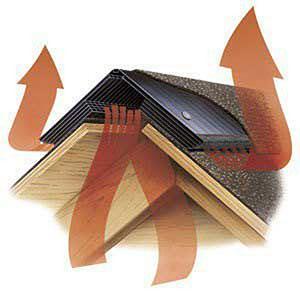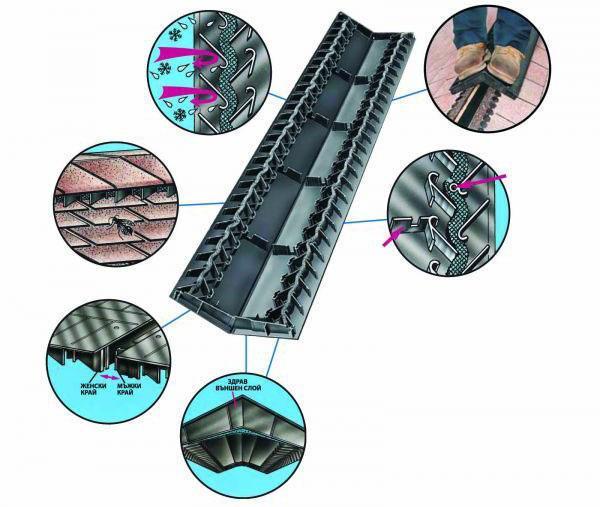Why do you need and how to mount a roofing aerator
 The roof of a building is a complex engineering structure. A roofing aerator is an element of air exchange and removal of excess moisture from the thermal insulation layer and structural elements.
The roof of a building is a complex engineering structure. A roofing aerator is an element of air exchange and removal of excess moisture from the thermal insulation layer and structural elements.
Consequences of improper roof installation
The roof is created to protect the building from atmospheric precipitation. It crowns the building, should be aesthetic and perform protective functions for the entire structure. Quality materials used to build a roof will be powerless in the damp stagnant air. So, only 3% of the moisture obtained by the mineral wool used for thermal insulation will violate its main function. The wooden rafters will rot and the corners will be moldy. Therefore, it is necessary to provide for roof ventilation in advance, at the design stage.
The manufacturer of roofing aerators Technonikol is purposefully conquering the vast building materials market. Production was founded in 1994 on the basis of the Vyborg ruberoid plant. Today, the enterprise is the first in the country to launch an enterprise for the production of PIR insulation material, popular in the West. Next in line is the launch of the fifth plant of basalt mineral wool.
TechnoNIKOL is the first company in the industry to provide not only a 10-year guarantee for certain types of products, but also liability insurance.
The roofing aerator helps remove excess moisture from under the rafter space. But in order for the warm heated air to be drawn out in the upper part under the ridge, it is necessary to organize an inflow in the lower zone of the cornice. How supply ventilation works:
- dormer windows;
- sub-cornice cracks;
- ventilation chambers.

If the soft roof does not have sufficient air exchange, it will quickly collapse, will not keep heat, and leaks will appear on the inside of the ceiling. Inevitably, water vapor from a heated dwelling will penetrate through the ceiling into the layer of mineral wool. There, cooling, moisture condenses, wetting the insulation. The water cannot rise higher, the bituminous roof interferes. This is how thermal insulation becomes unusable. The moisture released from it passes down through the ceiling.
Wet mineral wool insulation does not restore volume after drying, which means that the fibers are compressed and the air channels do not work. To restore thermal insulation, the material must be replaced.
The protective layer itself does not always lie tightly on the bitumen either. In places there are swellings in which the atmospheric air is located. Moisture condenses, then freezes and breaks the fragile base. The coating became unusable if the air exchange conditions were not met at the installation stage.
How to create aeration of a finished soft roof
 There are always water molecules in the air. In the room, each person evaporates a liter of liquid with sweat per day, and even conducts economic activities. The steam rises upwards and penetrates under the roof. You can get rid of dampness on the roof:
There are always water molecules in the air. In the room, each person evaporates a liter of liquid with sweat per day, and even conducts economic activities. The steam rises upwards and penetrates under the roof. You can get rid of dampness on the roof:
- drainage of condensate to the insulation;
- gradual weathering of excess moisture with removal into open space.
 Create a hood in the upper part of the roof, if it is a gable one, a ridge aerator for soft roofs TechnoNIKOL will help. Linear fixture, consisting of an angular linear element spaced from the slope by the height of the stiffeners. The resulting gap is covered with a seal through which air passes, but insects do not fly. From above, the plastic profile element is closed with a material intended for decorating the ridge. If you use ventilation bands inside the waterproofing and ridge aerators together, then this will be an air exchange system.
Create a hood in the upper part of the roof, if it is a gable one, a ridge aerator for soft roofs TechnoNIKOL will help. Linear fixture, consisting of an angular linear element spaced from the slope by the height of the stiffeners. The resulting gap is covered with a seal through which air passes, but insects do not fly. From above, the plastic profile element is closed with a material intended for decorating the ridge. If you use ventilation bands inside the waterproofing and ridge aerators together, then this will be an air exchange system.
A roofing aerator for a soft roof can be point if there is no slope on a flat roof, or the slope is long, more than 15 meters. Then a solid ridge and point aerators are installed. In this case, point aerators are located on a line separated from the top point by 0.5 -0.8 meters. If the roof is with a special configuration, the points are outlined by the designers, having studied the possibility of attic air exchange.
Types of point aerators
 If the roof is flat, pitched, or made as an extension to the wall, you will need to use point aerators for soft roofs.
If the roof is flat, pitched, or made as an extension to the wall, you will need to use point aerators for soft roofs.
They are produced by different manufacturers, have different designs and efficiency:
- The KTV aerator is a low design of a pocket raised on one side with a solid sole. The raised "tongue" forms a gap, decorated with a protective grill. Air comes out through it. Each device is capable of creating a hood from 20 m2 area.
- The KTV valve is a pipe on the bottom, covered from above with tiles in the color of the roof and enclosed in a lattice. Larger air vent provides 40 m2 under-roof ventilation.

- High structures are required when the roof is covered with snow and low slots can be buried. Tall elements are in the form of a pipe, covered with a cap on top. They can have a section of 75, 110, 160 mm, be installed on a ridge or slope at an incline of 14 and 27 degrees, this is the angle of the sole. An example of such an element is a roofing aerator TechnoNIKOL 160x460 mm in size.
The sequence of installing a point aerator on a soft roof
You can install a roofing aerator during the construction process. If the need arose during the operation of the building, it is possible to install air vents, but sealing of the associated parts will be required. The best way to improve air exchange is to install the aerator on a soft roof. Operating procedure:
- through the structure, to the waterproofing layer, a hole is cut out along the diameter of the aerator pipe;
- check the condition of the insulation, if necessary, replace it to increase the insulation effect;
- the sole of the aerator is pressed against the base, the density is ensured by a layer of mastic;
- the skirt is fixed with self-tapping screws;
- the damaged surface is waterproofed.
 The locations of the aerators are chosen based on their greater vulnerability. On a flat roof, such points are considered to be the joining points of the base. High aerators will become universal for installation on sloped beds. Effective turbine models include a roofing aerator technoNIKOL eco 160x450 mm. Its design allows installing an electric fan inside, thereby creating a forced acceleration of air exchange.
The locations of the aerators are chosen based on their greater vulnerability. On a flat roof, such points are considered to be the joining points of the base. High aerators will become universal for installation on sloped beds. Effective turbine models include a roofing aerator technoNIKOL eco 160x450 mm. Its design allows installing an electric fan inside, thereby creating a forced acceleration of air exchange.